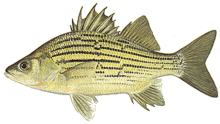Yellow bass
| Yellow bass | |
|---|---|

| |
| Scientific classification | |
| Domain: | Eukaryota |
| Kingdom: | Animalia |
| Phylum: | Chordata |
| Class: | Actinopterygii |
| Order: | Acanthuriformes |
| Family: | Moronidae |
| Genus: | Morone |
| Species: | M. mississippiensis |
| Binomial name | |
| Morone mississippiensis D. S. Jordan & C. H. Eigenmann, 1887 | |
| Synonyms | |
| |
The yellow bass (Morone mississippiensis) is a member of the family Moronidae. This species is a deep bodied fish that possesses five to seven dark stripes laterally along the sides, the lowest few of these are often broken or disrupted anterior to the origin of the anal fin. This species is somewhat similar to two other species in the family Moronidae, the white bass and the striped bass. The yellow bass is distinguishable from both of these species by having the offset lateral stripes above the anal fin and from not possessing tooth patches on the tongue. The yellow bass differs further from the white bass by having nine to ten anal rays in comparison to eleven or thirteen. The back of the fish is usually a dark olive green, and the abdomen and sides are often a silvery yellow.[3]
Diet
Food exploited by young yellow bass include small invertebrates including copepods and aquatic insects. The juvenile yellow bass feeds almost exclusively on aquatic insects and crustaceans, and once they reach adulthood they feed primarily on other small fishes; the rest of their diet consists of small crustaceans.[4]
Habitat and distribution
Yellow bass may be found in somewhat clear waters of the Mississippi River from Minnesota to Louisiana and may also be found in the Trinity River and the Tennessee River. The yellow bass can also be found in lakes surrounding these rivers, especially in areas with dense vegetation and low turbidity.[3] It may move into brackish estuaries.[5]
Reproduction and life cycle
The reproductive biology of the yellow bass is similar to that of the white bass, where spawning occurs during the spring with fish swimming into the tributaries to make spawning runs.[6][7] Spawning usually occurs in moderately shallow waters during which the female lies on her side and exposes the eggs as the male fertilizes from above. The larvae of the yellow bass school together to avoid predation and they grow fairly quickly in size.[6] Yellow bass have average lifespan of about six years.[3]
Importance to humans
The yellow bass is not as popular a gamefish as either the white bass or the striped bass because of its small size. They are usually caught by anglers fishing with crappie jigs or minnows. These fish may also be caught in large numbers because of their large populations.[3] The yellow bass is edible and this fish is commonly eaten in its range.[8]
The International Game Fish Association (IGFA) world record yellow bass, caught in the Morse Reservoir in Indiana in 2023, weighed 1.96 kg (4 lb 5 oz),[9] beating a 2000 record from the same lake of 1.34 kg (2.95 lb).[10] The IGFA record for a hybrid yellow bass (crossed with a white bass) stands at 1.81 kg (4 lb 0 oz), caught from Lake Fork Reservoir, Texas in 2023.[11]
Etymology
The specific name, mississippiensis, comes from the Mississippi River.[3]
References
- ^ NatureServe (2013). "Morone mississippiensis". IUCN Red List of Threatened Species. 2013: e.T202566A18236310. doi:10.2305/IUCN.UK.2013-1.RLTS.T202566A18236310.en. Retrieved 20 November 2021.
- ^ "Morone mississippiensis". NatureServe Explorer. 7.1. Retrieved 17 November 2022.
- ^ a b c d e Ross, Stephen (2001). Inland Fishes of Mississippi (1 ed.). Mississippi Department of Wildlife, Fisheries and Parks. pp. 395–396. ISBN 1-57806-246-2.
- ^ Kutkuhn, J.H (1955). Food and Feeding Habits of Some Fishes in a Dredged Iowa Lake. Iowa Academy of Sciences. pp. 576–588.
- ^ "Species: Morone mississippiensis, Yellow bass". Smithsonian Tropical Research Institute. 2015. Retrieved 9 July 2023.
- ^ a b Burnham, C.W. (1910). "Notes on the Yellow Bass". Transactions of the American Fisheries Society. 39: 103–108. doi:10.1577/1548-8659(1909)39[103:notyb]2.0.co;2.
- ^ Holland-Bartels, L.E.,S.K. (1990). A Guide to Larval Fishes of the upper Mississippi River. LaCrosse, Wisc.: National Fisheries Research Center.
{{cite book}}: CS1 maint: multiple names: authors list (link) - ^ "Yellow Bass | Species Breakdown". hookedinfishing.com. Retrieved 2022-09-28.
- ^ "Bass, yellow (Morone mississippiensis)". The International Game Fish Association. Retrieved 23 June 2024.
- ^ Junker, Phil (1 June 2007). "New World Record Yellow Bass Caught by Indiana Man at Morse Lake". fishin.com. Retrieved 9 July 2023.
- ^ "Bass, yellow (hybrid) (Morone mississippiensis x M. chrysops)". The International Game Fish Association. Retrieved 23 June 2024.


